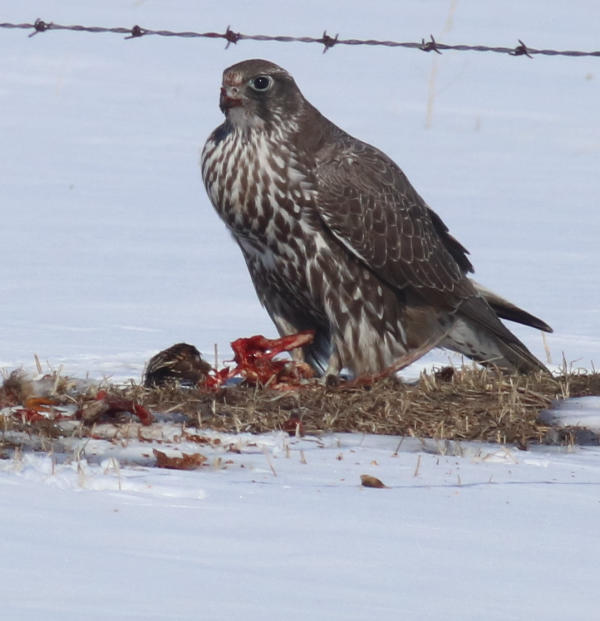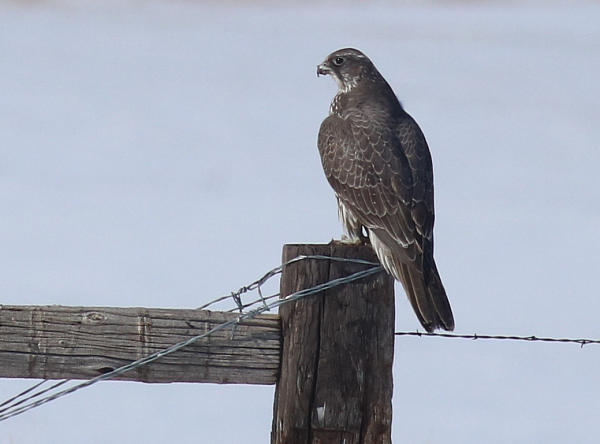
The “barbed wire” Gyrfalcon finishing a big feed (above), and perched (below).

|
Although they don’t show up in the weekly Rare Bird reports, Gyrfalcons are one of the rarest birds you will ever find! Unless you know of or find an Arctic nest site, the middle of winter is your best chance to find a Gyr – one of the most remarkable raptors in all the world! When you find your first one, your heart races and you no longer act within reason. You get tunnel vision and all you can see – all you can think about – is the grandest of all birds of prey – the incredible Gyrfalcon before you!
Gyrfalcons are rare throughout their range, which is limited to the circumpolar Arctic realm during the nesting season. During winter, some Gyrs move southward, and these are the birds we might encounter in the northern tier of states and southern provinces. They are the largest of all falcons in the world, and they are especially interesting due to their varied coloration that varies between almost black to almost white, with most birds colored shades of gray or brown.
Despite spending time in the Arctic in Russia, Alaska and Canada, all four of the Gyrfalcons I’ve found have been winter birds in the Dakotas. I found my first Gyr, a big dark-gray female, just seven miles north of my house many years ago. Two winters ago I found a very light-gray, almost white Gyr with light-brown markings. I only saw its silhouette in the rising sun, and my first thought was it might be a Ferruginous Hawk. As I turned off the side of the road I was able to see the bird in the morning light – a Big falcon, light-colored, close.
I immediately stopped the car, slammed it into park with my right hand, simultaneously opened the door with my left hand, hopped out and swung my telephoto in line with the gliding Gyrfalcon as it chased the rising sun. Exciting, but not much of a sighting – too fast and furious – but I managed a couple documentary photos that made the experience a bit more fulfilling. But I always wonder, what if . . . and can’t wait for the next opportunity. That episode exploded about 20 miles south of Pierre, South Dakota, in the Fort Pierre National Grasslands, part of my SoDak winter raptor hotspot that I described in the December 12 issue.
Barbed Wire Gyr
About a year later, I was driving 11 miles south of Pierre on a beautiful sunny day, counting and photographing raptors along the way. As I topped a hill I noticed a large raptor on the ground, under a barbed-wire fence, close to the road. My first thought was a Rough-legged Hawk, but as I approached closer, I second-guessed a Ferruginous Hawk, which made me more interested in stopping.
I raised my binoculars after pulling off the side of the road, only to realize this was a dark-brown Gyrfalcon crouched over the remains of a grouse. That’s when the jolt of excitement hit and I probably began shaking a bit in anticipation. The light wasn’t bad, but if I could get to the other side of the road, that would work better. I slipped out the door and warily moved to the back of my van to use it as cover to take a couple quick photos as the Gyr finished its feed, its crop bulging with fresh meat.
What luck, and what a sight to witness in close quarters. I was happy with the photos I was taking, aside from the barbed wire that appeared on the top of the images, but in a case like this, you take what you can get, while trying not to alter the behavior of the feeding bird. I was contemplating a next move when the rare Gyrfalcon beat me to the punch and took off low with a heavy wingbeat.
I followed the big falcon through my telephoto lens, but each photo I took had barbed wire as a signature part of the image. The first-year female Gyr perched a short distance away on the corner of a barbed-wire fence, where it cleaned its beak and feet after eating for a few minutes, then flew to a tree across a broad landscape where it remained the rest of the day. Wow! How exciting!
I caught my breath a moment, then walked to the prey remains and found that the bird of the day was a Greater Prairie Chicken; no meat was left. In the Arctic, Gyrfalcons often concentrate on similar-sized ptarmigan as prey (Rock or Willow Ptarmigan). I continued searching for, censusing and photographing other raptors to the south for the rest of the afternoon, but checked back on the Gyr to see that she was still in the same location – and would probably remain there overnight.
The next morning, while I was still a little groggy, I was headed south from Pierre again, and before I was seven miles south, I noticed a falcon perched on a pole. Could it be the Gyr? At first sight it seemed a bit smaller; was it a big Prairie Falcon?
As I pulled off the road I could see it was a Gyrfalcon; was it the same one? Perhaps yesterday’s gift had repositioned a few miles north. It was roughly the same color, but it seemed smaller. I photographed the bird as it perched with little interest in me, but before I really had the photos I wanted, a larger Rough-legged Hawk flew into my field of view only to force the Gyrfalcon to flee to my left, close. After the Gyr passed by it flew upward as the Rough-leg continued its pursuit; but the Gyrfalcon turned the table as it awaited the slower hawk, then dived swiftly downward on the Rough-leg time and time again before disappearing to the east.
When I caught my breath a moment, I realized this was probably a smaller male Gyrfalcon, and yesterday’s female could still be just a few miles south where I last saw her. I had to check it out; would yesterday’s female still be there? As I topped the hill, sure enough, the bigger Gyr had relocated back to a fencepost near the road, but this time it was not permitting any photography, and little observation time – it may have been back in hunt mode.
Nonetheless, I had observed two different wintering Gyrfalcons only a few miles apart within about 15 minutes! Not bad; who else can make that brag? (ha-ha)
Next . . .
I’d really like the opportunity to hang out with a Gyr in similar ways as I have with Golden Eagles, Prairie Falcons and hawks in the SoDak raptor hotspot – next time? Maybe I’d also wish for another light-colored Gyr – whitish, silverish . . . Can’t wait!
I was already on alert for my next Gyrfalcon last month, especially during trips to the Fort Pierre National Grasslands, and my intent elevated after a couple reports of Gyr sightings were logged in that region. The timing will be even better during my next trip – January and February are often the best times to find a Gyrfalcon.
A few Gyrfalcons have already been reported in widely scattered locations across the northern tier of states – in Washington, Oregon, Montana, northern Colorado, the Dakotas, Iowa, Illinois, Maryland, New York and along the St. Lawrence River to name a few American locations, with more in southern Canada. You can see where Gyrfalcons have been reported this winter season on ebird at https://ebird.org/map/gyrfal?neg=true&env.minX=&env.minY=&env.maxX=&env.maxY=&zh=false&gp=false&ev=Z&mr=12-2&bmo=12&emo=2&yr=range&byr=2018&eyr=2019 In the meantime, good luck on finding a Gyrfalcon of your own!
Article and photographs by Paul Konrad
Share your birding experiences anytime at editors2tbw@gmail.com